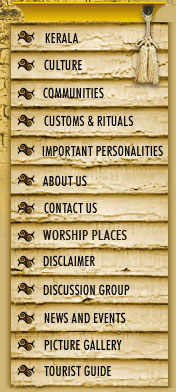Kerala
is renowned for its varied martial arts such as Kalarippayattu,
Parisa Kali. Velakali, Valeru, Kuntheru and Njaninmel Kali.
Kalaripayattu is the weaponry art of Kerala. ‘Keralolpahi’
says that Parasurama, the creator of Kerala distributed 108
‘nalpatheeradi’ positions with Kalari Godesses
to the Brahmins. However, it was the Nairs and Angachekavars
who excelled in Kalaripayattu. In general, Nairs were good
at payattu and weaponry. The stories of Thacholi Othenan and
Aromal Chekavars reveal this fact. Even women were not behind
in this field. Unniarcha is one of such heroines in the history.
Kalarippayattu combines self-defense techniques. The word
"Kalarippayattu" means martial training inside the
gymnasium.
Kalari in common terms means school or training centre. Kalari
is not only a learning centre, but a temple of religious worship
also with ritual of its own. History of Kalarippayattu can
be traced back to the Sanghom period. Communities of Nair,
Maravars, Nadars, Vellalas of this region practiced the martial
art of Kalarippayattu. Duarte Barbosa recorded that the earliest
reference to Kalarippayattu in a description of the Coasts
of East Africa and Malabar in the beginning of the 16th Century
A.D. He described that kalarippayattu as an already developed
martial art by that time. Elamkulam Kunjan Pillai, renowned
historian theorized that Kalarippayattu originated as a consequence
of the battles between the Cheras and the Cholas, which continued
all along the 11th century.
The training of Kalarippayattu is done in the Kalari. The
Kalarippayattu training aims at the ultimate co-ordination
of mind and body. Vadakkan Kalarippayattu (Northern style)
is associated with the Nair and Ezhava communities. Thekken
Kalarippayattu (Southern style) is the style practiced in
the Travancore area of Kerala. Vadakkan Kalripayattu has the influence of Ayurveda system of medicine
and Kathakali. Kalarippayyattu teachers provide massages with
traditional medicinal oils to their students in order to increase
their physical flexibility. Such massages are generally termed
"Thirummal” and the unique massage given to increase
physical flexibility is known as "Katcha thirumal”.
Thekkan kalari marmma treatment is much more sophisticated
than the vadakkan uzhichil. This treatment and other vital
points are based on the Tamil palm leaf manuscripts of Sage
Agasthya.

Chavutti thirummal
Training on Kalaripayatti
A student has to begin his Kalarippayatt training at an early
age of 7 or 8 with a formal initiation ritual performed by
the Gurukkal (Master). According to Vadakkan style, the training
is mainly divided into 3 parts consisting of Meythari, Kolthari
and Angathari. Apart from these, one more stage exists called
Verumkai. In the Thekkan style the training starts with Chuvadu
(solo forms), Jodi (partner training/sparring), Kurunthadi (small pole) Neduvadi (long pole), Katthi (knife), Katara (Dagon), Valum parichayum (sword and shield), double sword
and Marmma and Kalari wrestle. The master is called as Kalariasan.
A complete Kalarippayattu training is incomplete without learning
the medical aspects. The practitioner who has completed martial
training will be taught how to treat physical injuries with
traditional medicines.
The Parisa Kali of North Malabar and Velakali of Travancore
are two other martial art forms of Kerala, which involve considerable
physical training and knowledge of the use of the arms. Velakali represents the battle between Pandavas and Kauravas at Kurukshetra,
and is played out during the temple festival at
Ambalapuzha and Sree Padmanabha Swami Temple at
Thiruvananthapuram. There are other martial arts forms
like Valeru (sword throwing), Kuntheru (sphere throwing)
and Njaninmel Kali (rope walking).

Velakali |
|
 |
|



